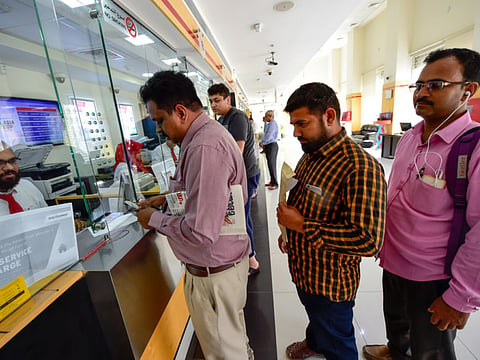Freefall of Indian rupee triggers large remittances
It’s a mixed picture with some benefits for expatriates and troublesome consequences for Indians back home

Gulf News spoke to a cross-section of Indian expatriates in the UAE to understand what the rupee’s free fall bodes for them.
Promoth Manghat, executive-director Finablr and Group CEO, UAE Exchange
Indian rupee is poised to fall further by year end...We did witness a good spike in remittances when the rupee touched the 70.00 mark for the first time and now we have observed remittances settling back to normality.
The Reserve Bank of India has adopted a hands-off approach to support the rupee during the Turkey-driven rout in emerging markets.
We did see some sign of RBI intervention when the rupee touched 70.40 and 70.50 against the US dollar, but it was not aggressive.
As for the future, we sense the rupee going down further to 72.00 or 73.00 by year end.
Suresh Massand, jeweller
“It’s time to invest in Indian markets. For Indian expatriates, it helps them increase their remittances and savings back home and invest in mutual funds and real estate.
However, it is bad news for our parents, relatives or families in India as the cost of living just shot up for them.
The transport costs and costs of day-to-day living get inflated in India and when the rupee recovers, these prices do not come down. People have to live with these marked-up prices.
Pawan Kumar, banking and finance consultant
The Indian rupee has been depreciating against the US dollar steadily over the last one year and there are many factors that can be ascribed to it. The main ones are depreciation of other emerging market currencies too; concern in India about the fiscal imbalance, increase in current account deficit, increase in the oil import bill, inflation fears and others. Previously, the Reserve Bank of India would intervene to check this depreciation.
However, the RBI which has about $400 billion [Dh1.47 trillion] worth of foreign currency reserves has not intervened recently, and appears to be allowing the rupee to slide closer to its real-effective exchange rate; and it might even drop a shade lower.
Kumar added it was important to see the silver lining beneath this dark cloud and also wait for the fall to level out.
The positive aspects of the fall are that most Indian expatriates stand to benefit around the world. This attracts an increase in remittances to India. Exporters in India stand to benefit too. The situation is bound to stabilise at a realistic level.
Mihir Buddhabhatti, bank executive
It is a net loss for expatriates investing in India. There are several factors linked to this. First, one should have the liquidity of finance to remit at the exact time when the currency falls.
If you do not have enough dirhams to spare, the fall will mean nothing to you.
Secondly, for those who have been consistently investing in mutual funds, stocks and real estate in India, while it may cost less to buy the stock or one may have a lower EMI on property, in terms of actuals, the percentage on returns has shrunk.
I invested in mutual funds and I will be getting lower return on it as well. My profits have fallen by five per cent .
Sign up for the Daily Briefing
Get the latest news and updates straight to your inbox



